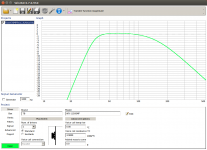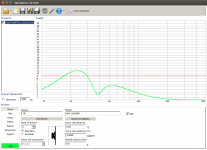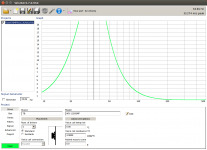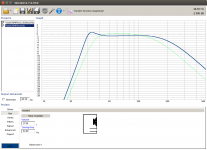Hi,
I'm going to build a modified voxel sub, for more information look here. It is based on the Tangband W5-1138SMF, for specs see this link..
Now since I live in Sweden I'm having some trouble getting the exact same components used for port and amp. So I've been messing around in WinISD to modify the box with other tubes and try to get the somewhere the same specs. First of all the only predefined element is W5-1138SA, what is the difference?
I've also searched everywhere to get a decent amp. It should be somewhere around 50-70W and I haven't decided to go for a plate amp or a stand alone. I'm up for any suggestions here really, hit me! DIY Audio boards are OK as long as there is a possibility to change freq, volume and preferably auto start but not a requirement.
I think that's it for now, help is very appreciated!
BR
Moe
I'm going to build a modified voxel sub, for more information look here. It is based on the Tangband W5-1138SMF, for specs see this link..
Now since I live in Sweden I'm having some trouble getting the exact same components used for port and amp. So I've been messing around in WinISD to modify the box with other tubes and try to get the somewhere the same specs. First of all the only predefined element is W5-1138SA, what is the difference?
I've also searched everywhere to get a decent amp. It should be somewhere around 50-70W and I haven't decided to go for a plate amp or a stand alone. I'm up for any suggestions here really, hit me! DIY Audio boards are OK as long as there is a possibility to change freq, volume and preferably auto start but not a requirement.
I think that's it for now, help is very appreciated!
BR
Moe
Hi again,
So played around a bit more with WinISD and came up with the below posted image.
The F3 is about 34.5Hz with a 9L box, 40x275mm tube length and a tuning freq of 37. Port air speed should be around 5.3m/s according to the graph, though I think it sounds low.
What do you experts say about this?
Is there anything more to check?
So played around a bit more with WinISD and came up with the below posted image.
The F3 is about 34.5Hz with a 9L box, 40x275mm tube length and a tuning freq of 37. Port air speed should be around 5.3m/s according to the graph, though I think it sounds low.
What do you experts say about this?
Is there anything more to check?
An externally hosted image should be here but it was not working when we last tested it.
What is the power and excursion used to develop 5.3m/s port air speed?The F3 is about 34.5Hz with a 9L box, 40x275mm tube length and a tuning freq of 37. Port air speed should be around 5.3m/s according to the graph, though I think it sounds low.
What do you experts say about this?
Is there anything more to check?
What is the power and excursion used to develop 5.3m/s port air speed?
I'm sorry but don't know what you mean. The cone excursion varies between 0.6mm and 1.7mm during the sweep and the power is set to 40W. I am total noob at this so please tell me how to check
OK, so you have checked that 40 watts only produces an excursion that varies between 0.6mm and 1.7mm, and port velocity of just 5.3m/s.I'm sorry but don't know what you mean. The cone excursion varies between 0.6mm and 1.7mm during the sweep and the power is set to 40W. I am total noob at this so please tell me how to check
The Tangband W5-1138SMF (Ferrite magnet) and neo magnet W5-1138SM both have a 9.25mm Xmax, so if you increase power to reach that level of excursion, the port velocity will also increase.
If you plan to use enough power to peak at 9.25mm excursion (probably over 200 watts if the information above is correct), the port may be undersized, but if you are not using more than 40-80 watts, it's OK.
Increasing the box size to around 13 liters (net) would make for more output using the full excursion potential without exceeding the 80 watt maximum power rating.
Last edited:
^^^What he said to start with....
You can play with port diameters or dimensions if you switch to square or rectangular. It will calc the length based on tuning freq. It needs to be big enough to keep air speed below say 16m/s at full power.
Be aware that tuning lower requires volume, both of the box and port. The 13L net box volume adds up to a box with driver and port of more like 25L gross if tuned to say 33Hz. (That is with a "slot" port on 2-2.5 sides of the main chamber).
You can play with port diameters or dimensions if you switch to square or rectangular. It will calc the length based on tuning freq. It needs to be big enough to keep air speed below say 16m/s at full power.
Be aware that tuning lower requires volume, both of the box and port. The 13L net box volume adds up to a box with driver and port of more like 25L gross if tuned to say 33Hz. (That is with a "slot" port on 2-2.5 sides of the main chamber).
OK, so you have checked that 40 watts only produces an excursion that varies between 0.6mm and 1.7mm, and port velocity of just 5.3m/s.
The Tangband W5-1138SMF (Ferrite magnet) and neo magnet W5-1138SM both have a 9.25mm Xmax, so if you increase power to reach that level of excursion, the port velocity will also increase.
If you plan to use enough power to peak at 9.25mm excursion (probably over 200 watts if the information above is correct), the port may be undersized, but if you are not using more than 40-80 watts, it's OK.
Increasing the box size to around 13 liters (net) would make for more output using the full excursion potential without exceeding the 80 watt maximum power rating.
OK i put in 40W when writing in the parameters for the driver, got from the Rated Power Input in the data sheet. Maybe I should've put in the Maximun Input power, i.e. 80W instead?
The idea is to make a small sub, used mainly for music. It will very rarley be pushed to max since I live in an apartment. But increasing to 13L, what size of the tube would be used? I would love to try to keep it around 10L if possible, of course sacrificing the lowest frequencies but probably I wont need this for music. Correct me if I'm wrong.
^^^What he said to start with....
You can play with port diameters or dimensions if you switch to square or rectangular. It will calc the length based on tuning freq. It needs to be big enough to keep air speed below say 16m/s at full power.
Be aware that tuning lower requires volume, both of the box and port. The 13L net box volume adds up to a box with driver and port of more like 25L gross if tuned to say 33Hz. (That is with a "slot" port on 2-2.5 sides of the main chamber).
Exactly! I want to try to keep is small. I'm also interested to know some guidelines as to how the response shoud look like etc and what other parameters to design after? Air speed below threshold, F3 and response are the main parameters or are there more that are important?
After buying a 12Volt power supply, the cost of a car amp is not cheap.Any suggestions for amp btw? I'm thinking about using this one, since it has variable crossover and more than enough power when bridged. I know it's for car use but I'm having trouble finding a good and cheap amplifier for home use. Comments/Thoughts?
Used receivers with a sub output can be a good value, but may not fit your form factor.
...How the ** did people design a small sub with this driver?
They compromised.... Allow that it'll be used close to a desk and you can reduce power requirements. That allows a smaller port x-section and length. Accept a higher tuning frequency and the box size can be reduced.
Going for a 32Hz full power build will result in a box about the size of a midi ATX computer case.
My "usual/original" computer audio system is a Videologic Sirocco crossfire. the sub for that is about the size of the computer case too.
They compromised.... Allow that it'll be used close to a desk and you can reduce power requirements. That allows a smaller port x-section and length. Accept a higher tuning frequency and the box size can be reduced.
Going for a 32Hz full power build will result in a box about the size of a midi ATX computer case.
My "usual/original" computer audio system is a Videologic Sirocco crossfire. the sub for that is about the size of the computer case too.
Alright! Another question; is the placement of the driver vs tube important? Can it be on the same side of the box, i.e. both facing front? Or putting the driver facing down and tube front etc.
Right now I have a modified version of the design but slightly bigger to go a tad deeper. I will never make <16m/s in the tube at full power though. More like 30-35m/s. As stated before it will very rarely be pushed hard so I don't think this is an issue. Correct me if I'm wrong, I've seen other posts saying that <30m/s is a limit to stay under. Seems very subjective? Is there any scientific limit where turbulence becomes an issue?
BR
Alright! Another question; is the placement of the driver vs tube important? Can it be on the same side of the box, i.e. both facing front? Or putting the driver facing down and tube front etc.
Right now I have a modified version of the design but slightly bigger to go a tad deeper. I will never make <16m/s in the tube at full power though. More like 30-35m/s. As stated before it will very rarely be pushed hard so I don't think this is an issue. Correct me if I'm wrong, I've seen other posts saying that <30m/s is a limit to stay under. Seems very subjective? Is there any scientific limit where turbulence becomes an issue?
BR
Add a subsonic filter to reduce the chance of overexcursion at lower frequencies.
Turbulence, port noise..... Build it well and use a large port. Properly flared and supported ports will do better than a chopped end to a pipe.
Port exit placement: It's a subwoofer, so no real issues. You might want to look at this - it might help (Or just add to uncertainties).
Calculating Subwoofer Port Length - Not So Simple - AVS Forum | Home Theater Discussions And Reviews
J.
Add a subsonic filter to reduce the chance of overexcursion at lower frequencies.
Turbulence, port noise..... Build it well and use a large port. Properly flared and supported ports will do better than a chopped end to a pipe.
Port exit placement: It's a subwoofer, so no real issues. You might want to look at this - it might help (Or just add to uncertainties).
Calculating Subwoofer Port Length - Not So Simple - AVS Forum | Home Theater Discussions And Reviews
J.
Large port doesn't rime with small sub since it needs to be longer.. Impossible equation
Some numbers on my current design:
Box: 8L
Port: 39x280mm (will be flared)
Tuning freq: 38Hz
F3: About 35Hz
See attached files for graphs. This is close to the original design of the Voxel sub which I also modeled. Any suggestions on improvments?
I also modeled a 18L box to see the difference. It would actually fit here so I'm thinking about building it instead. I reached a F3 of 28Hz and a tuning freq to 32, with a slightly different response, see last picture. Cone excursion about the same and air velocity below 29m/s.
Attachments
Last edited:
1) Yes, a "Catch 22". Passive radiators are a way around the increased cabinet volume lost to large ports, but are expensive.1)Large port doesn't rime with small sub since it needs to be longer.. Impossible equationSure I can add a subsonic filter.
2)But correct me if I'm wrong, overexcursion can occur below the tuning freq?
3)Since the tuning frequency of my current design is 38Hz I would need a filter there?
4)Or this is only when pushed hard?
5)I also modeled a 18L box to see the difference. It would actually fit here so I'm thinking about building it instead. I reached a F3 of 28Hz and a tuning freq to 32, with a slightly different response, see last picture. Cone excursion about the same and air velocity below 29m/s.
2) Excursion increases rapidly below Fb, the speaker "unloads" as it would in open air.
3) You can model the behavior at different drive levels that your amp will be capable of. In reality, the excursion will likely be a lot less than predicted. A steep 24 dB per octave BW (Butterworth) filter can be placed around 1/6th octave below Fb for protection.
4) If pushed hard enough, the driver can be damaged by over-excursion, but will probably make some nasty sounds before damage (Xlim, Xmech) occurs. If the voice coil hits the back plate when pushed hard, damage can occur in one cycle, but likely the suspension will reach it's end stops before that happens. Push in on the driver with your fingers to get an idea what happens past Xmax.
5) There is not a lot of program material below 28 Hz in most pop music, but the extra extension of the bigger box would be an improvement over the 38 Hz tuning, and won't "flap" as easily if you don't use a HP filter.
If the port velocity is high enough to blow out a candle at 30 centimeters, turn it down ;^).
Ok so made a few decisions regarding the design.
14L box with 51x300mm flared pipe will give me a nice design. I will run it with this amplifier, powered by a laptop AC/DC adapter giving 19VDC, 4A. This will give me more than enough power. Now regarding the filter, what design to use? I put a high pass filter of 25Hz into WinISD which made the cone excursion to go below max stroke, but I'm not to sure about the design and what components to use. Please enlighten me.
14L box with 51x300mm flared pipe will give me a nice design. I will run it with this amplifier, powered by a laptop AC/DC adapter giving 19VDC, 4A. This will give me more than enough power. Now regarding the filter, what design to use? I put a high pass filter of 25Hz into WinISD which made the cone excursion to go below max stroke, but I'm not to sure about the design and what components to use. Please enlighten me.
Ok so made a few decisions regarding the design.
14L box with 51x300mm flared pipe will give me a nice design. I will run it with this amplifier, powered by a laptop AC/DC adapter giving 19VDC, 4A. This will give me more than enough power. Now regarding the filter, what design to use? I put a high pass filter of 25Hz into WinISD which made the cone excursion to go below max stroke, but I'm not to sure about the design and what components to use. Please enlighten me.
Line Level Crossovers
Those can be found on eBay. Not a precise answer but maybe good enough?
Line Level Crossovers
Those can be found on eBay. Not a precise answer but maybe good enough?
Thanks! These are unavailable in Sweden though.. Any ideas on how to build one? Or other alternatives
- Status
- This old topic is closed. If you want to reopen this topic, contact a moderator using the "Report Post" button.
- Home
- Loudspeakers
- Subwoofers
- Building modified Voxel, some questions



